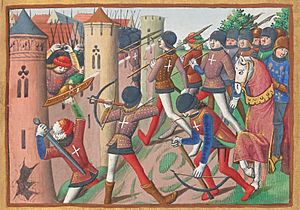Battle of Jargeau facts for kids
Quick facts for kids Battle of Jargeau |
|||||||
|---|---|---|---|---|---|---|---|
| Part of the Hundred Years' War | |||||||
 Battle of Jargeau, miniature from Vigiles du roi Charles VII |
|||||||
|
|||||||
| Belligerents | |||||||
| Commanders and leaders | |||||||
| Strength | |||||||
| 3,000 | 5,000 | ||||||
| Casualties and losses | |||||||
| Light | Heavy | ||||||
The Battle of Jargeau took place on June 11 and 12, 1429. It was an important event during the Hundred Years' War. This battle was part of the Loire Campaign. Here, the French forces, led by Charles VII of France, successfully took back control of many areas. This happened right after their big win at the Siege of Orléans. The Battle of Jargeau was a victory for Charles VII. It is also famous as Joan of Arc's very first battle where she led an attack.
Why the Battle Happened
By late 1428, the Hundred Years' War had been going on for a long time. The English and their allies, called the Burgundians, controlled most of northern France. They had also taken many key spots along the Loire River. Orléans, a major city on the river, had been under attack since October 1428. If the English had captured the entire Loire Valley, they could have easily invaded southern France. This was the last area still held by the French heir, known as the Dauphin.
In early March 1429, Joan of Arc arrived to meet the Dauphin, Charles VII. After being checked by church leaders, she joined a large army. This army set out to help Orléans, which was under siege. Their mission was a success. The English siege of Orléans was lifted by May 9.
After the siege of Orléans ended, Charles VII's army spent about a month getting stronger. They recruited more soldiers for their next military moves. In early June, French military leaders met with Charles VII. They decided to clear the Loire River valley of English troops. The bridge at Orléans had been destroyed by the English. Other bridges on the Loire, including the one at Jargeau, were held by the English. The army gathered at Orléans, and Joan rejoined them on June 9. That same day, they marched towards Jargeau.
Meanwhile, on June 8, a commander named Sir John Fastolf left Paris. He was leading an army of several thousand soldiers. They were heading to the Loire River valley to help the English.
Where the Battle Took Place
Jargeau was a small town in central France. It was located on the southern bank of the Loire River. The town was about ten miles east of Orléans. The English had captured Jargeau a few years earlier. They planned to use it as a base to invade southern France.
The town had strong defenses. It was surrounded by a wall with several towers and fortified gates. A ditch outside the walls made it even harder to attack. Outside the walls, there were also small villages called suburbs. A single fortified bridge crossed the Loire River to the north bank. This bridge was very important during the war. About 700 English soldiers defended Jargeau. They had weapons that used gunpowder.
The Battle Begins
Charles VII's army had many skilled commanders. These included Jean d'Orléans, Gilles de Rais, Jean Poton de Xaintrailles, and La Hire. The English defense of Jargeau was led by the Duke of Suffolk, William de la Pole.
The battle started with a French attack on the suburbs outside the town walls. The English defenders came out of the city to fight. The French soldiers then fell back. Joan of Arc used her special banner to encourage the French. This helped them to rally and fight harder. The English then retreated back inside the city walls. The French army stayed in the suburbs for the night.
The next morning, Joan of Arc asked the English defenders to give up. They refused her demand. The French then began a heavy attack with their artillery. They used early cannons and large machines to break down walls. One of the town's towers soon fell. Suffolk tried to talk about surrendering with a lower-ranking French captain, La Hire. This was not the usual way to surrender. It made the French commanders angry.
Joan of Arc then led an attack on the town walls. During the fight, a stone hit her helmet. It shattered against her head and knocked her down. But she quickly got back up. The English suffered many losses during this attack. The French soldiers killed many of the English prisoners they captured.
See also
- Jargeau
- Medieval warfare
- French military history

